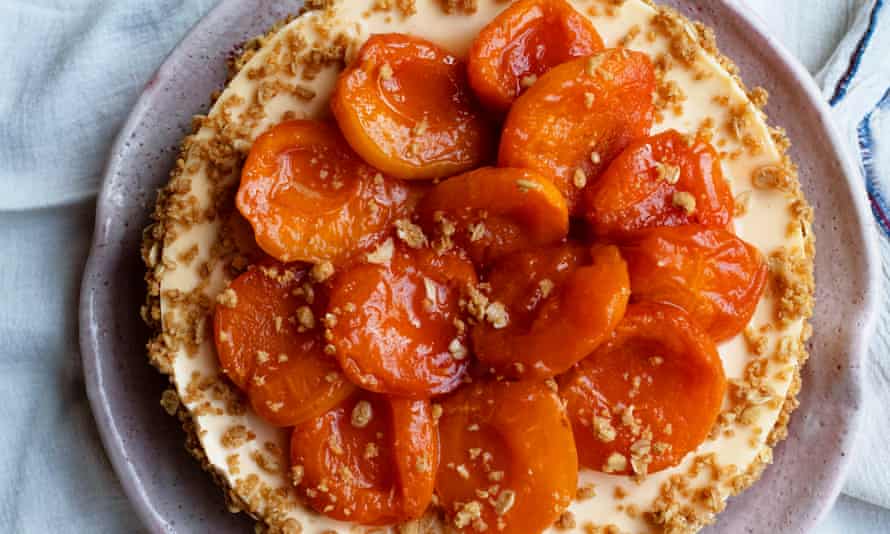
Of all the things I am unable to grow – cauliflowers, lavender, globe artichokes (the list is longer than I would like) – rhubarb remains the most frustrating. It grew in every garden when I was a kid; a free pudding with a bit of crumble on top. And when a bunch of asparagus seems cheaper than ever, I am now asked the most ridiculous price for a stick or two of rhubarb, yet continue to pay, if only for its glorious, spirit-lifting colour and the sort of lip-puckering tartness almost impossible to find elsewhere.
The mother of all crumbles aside, rhubarb chutney is what I like to serve with the rich, sweet fat of a pork chop or a massive butcher’s sausage. Good with cheese and a dazzling addition to a grilled mackerel, a chutney made with rhubarb (brown sugar, vinegar, chillies and mustard seed) is surprisingly good eaten hot, too.
The pink sticks were not the only things that dazzled on the kitchen table this week – a bag of blushing Turkish apricots, the first of the season, lacked their usual honeyed sweetness until I simmered them with orange juice and a little sugar to eat with a fudgy, stick-to-the-fork cheesecake.
Baked sausages, rhubarb chutney
You can bake the sausages without browning them on the hob first, but I find giving them a good sizzle before they reach the oven gives a juicier result. Go for fat, open-textured pork sausages with plenty of pepper in them – a proper breakfast sausage. Serves 4
thyme 8 small bushy sprigs
fat butcher’s sausages 12
groundnut oil 3 tbsp
For the chutney:
red onions 2
granulated sugar 200g
white-wine vinegar 250ml
chillies 4, small and hot
star anise 2, whole
mustard seeds 1 tbsp
coriander seeds 1 tsp
sea salt ½ tsp
orange 1, small
rhubarb 300g
For the chutney, roughly chop the onions. Put them into a stainless-steel, or other nonreactive pan, with the sugar and vinegar and bring to the boil.
Add the whole chillies, the star anise, mustard seeds and coriander seeds, then the salt, and leave to simmer over a moderate heat.
While the onions continue to soften, remove the zest from the orange in short lengths, then cut each into fine matchstick-like strips, as thin as you can make them. Stir into the onions and continue to cook for 15 minutes, until the mixture has thickened.
Cut the rhubarb into pieces about the size of a wine cork, add to the onion mixture and continue cooking for 10 minutes, until it has softened but not completely collapsed. Remove from the heat and serve hot or cold.
To cook the sausages, preheat the oven to 200C/gas mark 6. Remove the leaves from 4 thyme sprigs and stir into the oil. Place the sausages and thyme-oil in a heavy-based baking dish (I use a shallow cast-iron casserole) and brown them lightly on all sides over a medium heat. Add the remaining thyme sprigs and then transfer the dish to the oven and bake for 30 minutes until the sausages are golden brown. Bring to the table with the hot rhubarb chutney.
Creamy cheesecake with apricots
The cheesecake is cooked when the outside edge is firm, but should still quiver in the centre when shaken gently. Leave it in the oven to cool, then refrigerate overnight. The texture will change during this time, to give a firm but exceptionally creamy texture. The accompanying fruit should be not too sweet, to offer some contrast to the cake. Serves 8
butter 80g
sweet oat biscuits 200g
rolled oats 3 tbsp
mascarpone 500g
full-fat cream cheese 200g
golden caster sugar 150g
large eggs 3, plus 1 yolk
lemon 1
orange 1
double cream 150ml
vanilla extract ½ tsp
For the apricots:
apricots 350g
orange juice reserved from above
caster sugar 50g
Melt the butter in a saucepan. Crush the biscuits to a fairly fine powder. You can do it in the traditional way with a plastic bag and a rolling pin or in a food processor. Tip the biscuits and oats into the melted butter and stir unbrieflytil all are coated. Set the oven at 140C/gas mark 1. Press two-thirds of the buttered crumbs into the base of a deep 20-22cm loose-bottomed cake tin. Set aside in a cold place to become firm. The freezer is ideal.
Put the kettle on. Put the mascarpone, cream cheese, sugar, eggs and extra egg yolk in the bowl of a food mixer (you will need the flat beater attachment). Finely grate in the lemon and orange zeststo the cheese and sugar, then beat until thoroughly mixed. Squeeze the lemon (reserve the orange). Fold in the cream, lemon juice and vanilla extract to the cheesecake mix.
Wrap the base of the cake tin with foil, covering the base and sideswith a single piece with no joins, then pour in the cheesecake mixture. Lower the cake tin into a roasting tin. Pour enough of the boiled water from the kettle into the roasting tin to come halfway up the sides of the cake tin. Slide carefully into the oven. Bake for 50 minutes, then switch off the oven and leave the cheesecake in place to cool.
When it has cooled, chill it for a couple of hours in the fridge. (Overnight won’t hurt.) Release it from its tin and slide it on to a plate. Press the reserved crumbs on to the sides of the cake.
Meanwhile, cut the apricots in half and discard the stones. Put the orange juice, caster sugar and 100ml of water into a stainless-steel pan. Add the apricots and bring to the boil. Lower the heat to a gentle bubble and let the fruit cook for about 10-15 minutes until soft. Remove from the heat and leave to cool. Refrigerate until thoroughly cold. Serve the apricots with the cheesecake, either at the side or, drained of the juice, on top of the cake. Serve the juice in a small jug.
Follow Nigel on Twitter @NigelSlater



